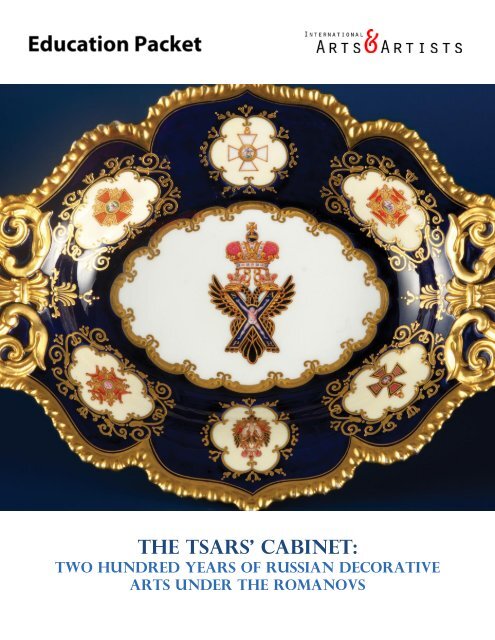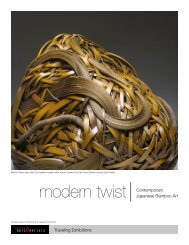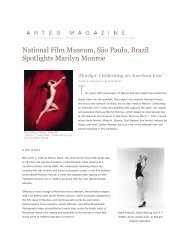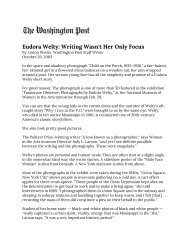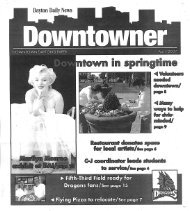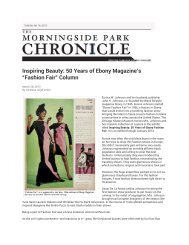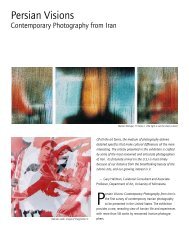thE tSARS' CABINET: - International Arts & Artists
thE tSARS' CABINET: - International Arts & Artists
thE tSARS' CABINET: - International Arts & Artists
You also want an ePaper? Increase the reach of your titles
YUMPU automatically turns print PDFs into web optimized ePapers that Google loves.
The Tsars’ Cabinet:<br />
Two Hundred Years of Russian Decorative<br />
<strong>Arts</strong> under the Romanovs
The Tsars’ Cabinet:<br />
Two Hundred Years of Russian Decorative <strong>Arts</strong> under the<br />
Romanovs<br />
Education Packet<br />
Table of Contents<br />
Introduction………………………………………………..2<br />
Glossary……………………………………………...........5<br />
Services…………………………………………………….7<br />
The Romanov Dynasty.……………………………..............9<br />
Meet the Romanovs……….……………………………….10<br />
Speakers List...…………………………………..………...14<br />
Bibliography……………………………………………….15<br />
Videography……………………………………………….19<br />
Children’s Activity…………………………………………20<br />
The Tsars’ Cabinet: Two Hundred Years of Russian Decorative <strong>Arts</strong> under the Romanovs is developed from the Kathleen<br />
Durdin Collection and is organized by the Muscarelle Museum of Art at the College of William & Mary,<br />
Williamsburg, Virginia, in collaboration with <strong>International</strong> <strong>Arts</strong> & <strong>Artists</strong>, Washington, DC.
The Tsars’ Cabinet<br />
This exhibition illustrates more than two hundred years of Russian decorative arts: from the time of<br />
Peter the Great in the early eighteenth century to that of Nicolas II in the early twentieth century.<br />
Porcelain, glass, enamel, silver gilt and other alluring materials make this extensive exhibition dazzle and the<br />
objects exhibited provide a rare, intimate glimpse into the everyday lives of the tsars. The collection brings<br />
together a political and social timeline tied to an understanding of Russian culture. The Tsars’ Cabinet will<br />
transport you to a majestic era of progressive politics and dynamic social change.<br />
The Introduction of Porcelain to Russia<br />
During the late seventeenth and early eighteenth centuries, Europe had a passion for porcelain. It was not until<br />
1709 that Johann Friedrich Böttger, sponsored by Augustus II (known as Augustus the Strong) was able to<br />
reproduce porcelain at Meissen, Germany.<br />
After Augustus II began manufacturing porcelain at the Meissen factory, other European monarchs attempted<br />
to establish their own porcelain factories. The earliest records of Russian attempts to obtain the secret to<br />
porcelain production occurred during the reign of Peter the Great, who was fascinated with Western culture,<br />
and perpetuated its spread in his own country.<br />
Prior to Johann Friedrich Böttger’s success and the establishment of the Meissen factory in Germany, all<br />
porcelain came from China. The high cost of transporting the delicate merchandise meant that ownership was<br />
confined to royalty and the very wealthy. Many sovereigns had entire rooms dedicated to the display of their<br />
porcelain treasures. Porcelain services were often given as gifts between monarchs.<br />
The first Russian porcelain was produced at the Imperial Porcelain Factory in 1747 during Empress Elizabeth’s<br />
reign. Empress Elizabeth was succeeded by her nephew Peter III, whose reign lasted a brief 182 days before he<br />
was dethroned in a coup led by his wife Catherine II, also known as Catherine the Great.<br />
Enlightened Despotism<br />
Catherine the Great was a great proponent of the philosophies of the Enlightenment, and aimed to bring these<br />
ideals to Russia through culture, politics and military expansion. The enlightened despot’s court attracted<br />
outstanding artists, architects and decorators from all over Europe. The Neoclassical style prevalent across<br />
Europe was reflected in Russia’s architecture and decorative arts, and classical imagery was even used to<br />
support Catherine the Great’s legitimacy as a ruler.<br />
The practice of giving gifts of porcelain services among monarchs continued throughout the eighteenth<br />
century. Catherine continued her predecessor’s patronage of the Imperial Porcelain Factory, and the first great<br />
ceremonial service, known as the Arabesque Service, was produced in 1784 and was followed a year later by<br />
the Yacht Service. With its founding in 1766, the Francis Gardner Factory became the first private factory to<br />
manufacture Russian porcelain, producing pieces for both imperial order and private commissions.<br />
2
Militarism and Russian Historicism<br />
Nicholas I was an even greater patron of the Imperial Factory than his grandmother, Catherine the Great.<br />
Military-themed plates became increasingly popular during the reign of Nicholas I. Painted by the finest artists<br />
of the Imperial Porcelain Factory, these plates represented specific military units and ranks, and were<br />
decorated with depictions of pieces of armament and equipment.<br />
Among the most distinctive motifs of Russian historicism was a Russo-Byzantine style, using decoration from<br />
sixteenth and seventeenth century Russia. In 1830, Nicholas I commissioned Fedor Solntsev to copy items in<br />
the Kremlin Armory and wall ornamentation from Russian churches. Tsar Nicholas was so pleased with the<br />
work produced by Solntsev that he commissioned a large banquet service based on these designs for the<br />
Kremlin Palace, known as the Kremlin Service.<br />
Nicholas I was instrumental in the perpetuation of the Russian porcelain tradition. He began the practice of<br />
producing additions to many of the earlier major services, whether Russian or foreign in origin, a practice that<br />
continued throughout the remainder of the empire. His successors, Tsars Alexander II and III, however, were<br />
less interested in the arts, and innovation at the state factories suffered. Items made during these reigns were<br />
most often additions to or continuations of previous designs and were often not as elaborate as some of those<br />
produced during the reign of Nicholas I.<br />
The tradition of producing Imperial yacht services by the Imperial Porcelain Factory and the Imperial<br />
Glassworks began during Alexander II’s reign. These yacht services were perhaps the most private of all those<br />
made in the nineteenth century, as they were intended for the Imperial family and their companions. Heavier<br />
and squatter than similar wares produced for the palaces, the items are practically shaped for greater stability<br />
on shipboard.<br />
The other major exception to the remarkable production during the reigns of Nicholas’ son and grandson is the<br />
Raphael Service—one of the most significant services of the late nineteenth and early twentieth century. The<br />
Raphael Service was commissioned in 1883, during the reign of Alexander III. The decoration of this service<br />
featured allegorical figures derived from the frescoes by Raphael in the loggias of the Vatican and the project<br />
took twenty years to complete. Even the markings reflect the elaborate decoration of this service.<br />
While raised in St. Petersburg where the culture focused on westernized motifs, Nicholas II became<br />
increasingly interested in the motifs of the Old Russian Style. He was particularly taken by the designs of<br />
seventeenth century Russia, during the time of his favorite tsar, Peter the Great’s father, Tsar Alexei. Several<br />
of the important cultural events of Nicholas II’s reign incorporate these seventeenth century styles. The<br />
Imperial Ball of 1903, the last one held at the Winter Palace, featured the court dress of the tsar’s ancestors—<br />
Nicholas and Alexandra wore the attire of Tsar Alexei and his first wife, Maria Miloslavskaia. The Kremlin<br />
Service, decorated in the Old Russian style, was used during the 1913 celebrations of the Tercentenary of the<br />
founding of the Romanov dynasty, thus providing another visual link to the past.<br />
The End of a Dynasty<br />
Following the assassination of Grand Duke Franz Ferdinand and Grand Duchess Sophie in 1914, and the<br />
Austrian ultimatum against Serbia, Russia declared war on Austria. Initially, the country entered the war under<br />
a mood of national unity and patriotism. Crowds cheered the Tsar and his family in St. Petersburg and much of<br />
the decorative arts made during the early years of the war reflected this attitude of nationalism and austerity.<br />
In 1917, Emperor Nicholas II abdicated and a provisional government was formed, ending the reign of the<br />
Romanovs. This short-lived government was overthrown in what was known as the Bolshevik Revolution.<br />
3
Following the Revolution, the Grand Duchess Elizabeth was imprisoned in the Urals along with five other<br />
Romanovs. They were murdered at Alapayevsk on July 17, 1918, the day after Nicholas, Alexandra, their<br />
children and many other members of the former Imperial family were killed at Yekaterinburg.<br />
4
Glossary<br />
CARTOUCHE/<br />
RESERVES<br />
COLLECTION<br />
CORONATION<br />
An oval or oblong shape enclosing an image.<br />
An accumulation of objects that may be centered upon a medium or technique, a<br />
certain period or group of artists, or a subject, for instance; or they may be<br />
encyclopedic.<br />
The ceremony of crowning a king, queen, or other sovereign.<br />
CACHE-POT<br />
An ornamental receptacle to hold and usually to conceal a flowerpot.<br />
CAVETTO<br />
Sunken center of a flat dish, plate, or soup plate.<br />
CHARGER<br />
A Large, formal decorative plate.<br />
CHARKA<br />
A drinking vessel used in Russia, meaning vodka or tot cup.<br />
CIPHER<br />
CISELE<br />
A combination of symbolic letters; especially the interwoven initials of a name<br />
(monograph).<br />
Metallic painting having a chased or chiseled appearance.<br />
COMPOTIER/<br />
COMPOTE<br />
EWER<br />
A dish for holding compotes, fruit, etc.<br />
A vase-shaped pitcher or jug.<br />
EN GRISAILLE<br />
A term for paintings executed entirely in monochrome or near-monochrome, usually<br />
in shades of grey.<br />
FILE<br />
FINIAL<br />
A special centerpiece that usually related to a theme of gardens, one taken from<br />
mythology or various allegories.<br />
A decorative end piece knob.<br />
HIGH-FIRE<br />
UNDERGLAZE<br />
PAINTING<br />
METALLURGY<br />
Learned from Danish craftsmen, this technique was produced under the reign of<br />
Alexander III (1181-1894) and found on array of vases, often painted with scenes<br />
recalling the haunting landscape of this northern land.<br />
The process of heating metal to give them a certain desired shape and technique of<br />
compounding alloys or separating metal from their ores.<br />
5
HARD-PASTE<br />
PORCELAIN<br />
MOTIF<br />
NEOCLASSICAL<br />
NEOROCOCO<br />
STYLE<br />
OVERGLAZE<br />
Porcelain including a mixture of kaolin, feldspar, and quartz, fired at a very high<br />
temperature producing a strong and translucent ceramic.<br />
A recurring subject, theme, idea in both literature and art.<br />
A characteristic of a revival of the earlier classical style of ancient Greece and Rome.<br />
A style variety of the mid-19 th century that reflected the prevailing Western lifestyle<br />
and conservatism of the court, during the reign of Nicholas I (1825-1855).<br />
A painted or printed decoration applied over a glaze.<br />
PATTERN<br />
PORCELAIN<br />
PUCE<br />
PROSPEKTMALERE<br />
ROYAL BANQUET<br />
RUSSIAN REVIVAL<br />
MOVEMENT<br />
SERVICE<br />
SOFT-PASTE<br />
PORCELAIN<br />
SOURTUT<br />
D’TABLE<br />
Lines, shapes and colors that repeat.<br />
A ceramic piece made from a mixture of clays and kaolin that was first used in China in<br />
the 17 th century. After firing in a kiln (clay oven), porcelain is hard, white and<br />
translucent.<br />
A color ranging from deep red to dark gray or brown.<br />
Also known as, veduta esata, the painting of recognizable cityscapes found on services<br />
commissioned by Alexander I (r.1801-1825) and Nicholas I (r.1825-1855). These<br />
paintings reflected Russian’s growing national pride.<br />
A large gathering of the upper class usually consisting of dancing and an extravagant<br />
meal.<br />
A term referring to the many different architectural movements in the 19 th century in<br />
Russia. It was often classified as a combination of pre-Peterine Russian and Byzantine<br />
architecture.<br />
Tableware consisting of a complete and matching set of items – silver and porcelain<br />
particular for dining or entertaining use.<br />
The precursor to hard-paste porcelain, developed at various European factories such as<br />
Sèvres. The earliest formulations were mixtures of clay and ground-up glass (frit).<br />
These wares were of lesser quality than the later, or hard-paste, porcelain as they were<br />
not hard and vitrified by firing kaolin clay at high temperatures.<br />
A special centerpiece that filled the center of the dessert table. It usually related to a<br />
theme of gardens, one taken from mythology, or various allegories.<br />
STRAP-WORK<br />
UNDERGLAZE<br />
Interlace designs of ropes and chains to form double-headed eagles and anchors.<br />
Coloring or decoration applied to pottery before glazing.<br />
6
Services<br />
MEISSEN DESSERT<br />
SERVICE, 1745,<br />
MEISSEN PORCELAIN<br />
FACTORY, GERMANY<br />
HER MAJESTY’S<br />
OWN SERVICE, 1756,<br />
IMPERIAL PORCELAIN<br />
FACTORY<br />
ORLOV BREAKFAST<br />
SERVICE, 1765,<br />
IMPERIAL PORCELAIN<br />
FACTORY<br />
CAMEO SERVICE, 1777,<br />
IMPERIAL PORCELAIN<br />
FACTORY<br />
ARABESQUE SERVICE,<br />
c.1784,<br />
IMPERIAL PORCELAIN<br />
FACTORY<br />
YACHT SERVICE, c.<br />
1785<br />
IMPERIAL PORCELAIN<br />
FACTORY<br />
EVERYDAY SERVICE,<br />
1838, IMPERIAL<br />
PORCELAIN FACTORY<br />
Gifted to Elizabeth from Augustus III Elector of Saxony on the occasion of the<br />
marriage of her nephew Peter (Peter III) to Princess Sophia Anhalt-Zerbst<br />
(Catherine the Great.) Decorated with the Russian double-headed eagle and the<br />
Cross of St. Andrew alternating with flowers, this service began the tradition of<br />
special dessert services for banquets honoring the knights of Russia’s principle<br />
orders, in this case, the Order of St. Andrew First Called.<br />
A dessert service, the first to be made at the Imperial Porcelain Factory.<br />
Produced in two parts and gifted by Catherine to Count Grigorii Orlov, the tea<br />
service and plates have Orlov’s initials GCO in Cyrillic in gold within a wreath of<br />
laurel leaves, with flags, banners, and cannon in silver to the side. Tenting scenes<br />
encircle the cups and the rims of the plates. The second part of the service<br />
included a mirror and utensils for shaving and dental tools and is neoclassical in<br />
design, with military scenes painted in polychrome.<br />
Both a full dinner and dessert service, this soft-paste porcelain service was<br />
commissioned by Catherine the Great for General Grigorii Potemkin. The dessert<br />
centerpiece featured the “Russian Parnasus” with Minverva, goddess of wisdom on<br />
a pedestal surrounded by the Muses, a reference to Catherine’s own wisdom,<br />
virtue and judgment. This service was created at the Sevres Porcelain<br />
Manufactory, France.<br />
A hard-paste porcelain service, the first full porcelain service produced by the<br />
Imperial Porcelain Factory. This service features a neoclassical design taken from a<br />
wall ornament found in the recently discovered cities of Pompeii and Herculaneum<br />
that had been destroyed by the eruption of Vesusius in August 79 AD.<br />
Similar to the Arabesque Service, the Yacht Service feature motif or medallion is<br />
the flag of the merchant marine. The merchant flag alludes to the prospect of<br />
increased commerce which the acquisition of the Black Sea ports promised. The<br />
Yacht Service was used interchangeably with the Arabesque Service and extended<br />
the theme of the powerful Catherine into the realm of commerce and new lands in<br />
the South.<br />
“Everyday” or “ordinary” services were used as everyday ware for all of the palaces.<br />
All featured similar motifs; some had a molded basket-weave rim, others had a<br />
plain rim, but all were decorated with so-called “Deutsche Blumen (German<br />
flower)” roses.<br />
7
GATCHINA PALACE<br />
SERVICE, c.1830,<br />
MEISSEN PORCELAIN<br />
FACTORY, GERMANY<br />
GURIEV SERVICE, 1809,<br />
IMPERIAL PORCELAIN<br />
FACTORY<br />
GURIEV SERVICE, 1826,<br />
IMPERIAL PORCELAIN<br />
FACTORY<br />
KREMLIN SERVICE,<br />
1837<br />
IMPERIAL PORCELAIN<br />
FACTORY<br />
YACHT DERZHAVA<br />
SERVICE, 1871,<br />
IMPERIAL PORCELAIN<br />
FACTORY<br />
Named after the Gatchina Palace, where in several members of the Romanov<br />
dynasty lived, this service marked the change of order services no longer being<br />
used just for dessert.<br />
Commissioned by Catherine’s grandson, Nicholas I, this service is one of the<br />
grandest ever produced at the Imperial Factory and certainly the largest. Originally<br />
known as “the service with illustrations of Russian Costumes,” it featured Tureens<br />
and ice pails painted with architectural views of St. Petersburg and its<br />
surroundings. Dessert plates featured ethnic types, tradesman, and artisans derived<br />
from various sources.<br />
A service ordered by Nicholas I for his coronation in 1826, this service features the<br />
imperial coat-of-arms—the double-headed eagle, encircled by the Chain of St.<br />
Andrew, placed on an ermine mantel and surmounted by the imperial crown.<br />
Helmets, trophies and lion masks decorate the rims of the dinner plates, and<br />
griffins, the symbol of the Romanov family, and wreaths are found on the dessert<br />
plates. All are rendered in tooled gold on a cobalt blue background.<br />
Also commissioned by Nicholas I, this service introduced a rich source of<br />
decoration into Russia’s vocabulary of ornament. For the first time artists drew<br />
inspiration from old Russian motifs dating to the seventh century. The Kremlin<br />
Service was intended for five hundred people, with two thousand dinner plates,<br />
one thousand soup plates and one thousand dessert plates. It took over ten years to<br />
complete the painting of the entire service.<br />
The tradition of producing Imperial yacht services began during Alexander II’s<br />
reign. These yacht services were perhaps the most private of all those made in the<br />
nineteenth century and were intended for the Imperial family and their close<br />
friends. These items were heavier and squatter than other wares produced for the<br />
palaces—practically shaped for greater stability on shipboard<br />
8
The Romanov Dynasty<br />
Below is a condensed Romanov family tree, limited to only those who became or<br />
begat Romanov rulers of Russia.<br />
TSAR<br />
Maria<br />
Miroslavsk<br />
aya<br />
Mikhail I<br />
1613-1645<br />
Alexei I<br />
1645-1676<br />
Eudoxia<br />
Streshneva<br />
Natalia<br />
Naryshkina<br />
regent<br />
Parent of<br />
future Tsar<br />
Praskovia<br />
Saltykova<br />
Ivan V<br />
1682-1696<br />
SoPHia<br />
1682-1689<br />
Feodor III<br />
1613-1645<br />
Anna<br />
1730-1740<br />
Frederick<br />
Wilhelm<br />
Eudoxia<br />
Lophukina<br />
Peter I<br />
1682-1725<br />
Catherine I<br />
1725-1727<br />
Anthony<br />
Ulrich<br />
Anna<br />
Leopoldovna<br />
Charlotte<br />
Christine<br />
Alexei<br />
Petrovich<br />
Charles<br />
Frederick<br />
Anna<br />
Petrovna<br />
Elizabeth<br />
1741-1761<br />
Ivan VI<br />
1740-1741<br />
Peter II<br />
1727-1730<br />
Peter III<br />
1761-1796<br />
Catherine II<br />
1761-1796<br />
Maria<br />
Feodorovna<br />
Paul<br />
1796-1801<br />
Alexandra<br />
Feodorovna<br />
Nicholas I<br />
1825-1855<br />
Konstantin<br />
(abdicated)<br />
Alexander I<br />
1801-1825<br />
Alexander II<br />
1855-1881<br />
Maria<br />
Alexandrovna<br />
Maria<br />
Feodorovna<br />
Alexander III<br />
1881-1894<br />
Nicholas II<br />
1894-1917<br />
9
Meet the Romanovs<br />
MIKHAIL I<br />
1596 – 1645<br />
REIGNED: 1613-1645<br />
Mikhail Fedorovich became the founder of the Romanov dynasty when he was<br />
elected Tsar of Russia in 1613 by a national assembly. Only 17 years old, Mikhail<br />
was unanimously voted in by the boyars, Russia’s ruling class.<br />
ALEXEI I<br />
1629-1676<br />
REIGNED: 1645-1676<br />
The son of Tsar Mikhail and Eudoxia Streshneva, Alexei ascended to the throne at<br />
the age of 16. Alexei’s first wife, Maria Miloslvskaya, died shortly after bearing<br />
Alexei’s 13 th child. He then married Nataliya Kyrillovna Naryshkina in 1671. The<br />
decades of Alexei’s reign were marked by tumult and revolution, with riots in<br />
Moscow, wars with Poland and Sweden, and strained relations with England after<br />
the Parliamentarian beheading of Charles I.<br />
FEODOR III<br />
1661 –1682<br />
REIGNED: 1676-1682<br />
Feodor III, the eldest surviving son of Tsar Alexei, took the throne at 15 years of<br />
age. Despite suffering from paralysis and disfigurement, the highly educated Tsar<br />
Feodor led his country through significant reforms in the Church, as well as<br />
ridding Russia of the restrictive hierarchical system which granted citizens of<br />
noble birth higher posts in state and military, replacing it with a merit-based<br />
system. Childless, with a disabled brother next in line to the Russian throne,<br />
Feodor’s death triggered the Moscow Uprising of 1682.<br />
IVAN V<br />
1666 —1696<br />
REIGNED: 1682-1696<br />
The last surviving son of Tsar Alexei and Maria Miloslavskaya, Ivan V suffered<br />
from both mental and physical disabilities which made him reluctant to take his<br />
place on the throne. Ivan eventually became joint Tsar of Russia with his 10-<br />
year-old half-brother, Peter. Both unsuited to lead the country, their power was<br />
held by their older sister Sophia Alekseyevna until 1689. Ivan died young at the<br />
age of 29.<br />
SOPHIA<br />
1657 – 1704<br />
REGENT: 1682-1689<br />
The daughter of Tsar Alexei and his first wife Maria, Sophia Alekseyevna came to<br />
power when her brother, Tsar Feodor, died childless. With Ivan, a disabled 16-<br />
year-old, next in line to the throne, and the family of her step-mother pressing<br />
for the even younger Peter to become Tsar, Sophia became regent in order to<br />
ensure Ivan’s position, and her family’s power, was not usurped. Her reign<br />
ended seven years later when Ivan sided with Peter against her.<br />
PETER I (THE<br />
GREAT)<br />
1672 – 1725<br />
REIGNED: 1682-1725<br />
Peter I and his older half-brother Ivan were crowned joint tsars, with their halfsister<br />
Sophia as regent. Sophia was overthrown in 1689 and Ivan died in 1696,<br />
thrusting Peter to power as the sole tsar. Russia grew as the result of several<br />
successful wars during his reign, becoming increasingly powerful. Peter<br />
instituted a number of reforms to ingrain Western customs into Russian life and<br />
founded the city of St. Petersburg, which became capital of Russia in 1712.<br />
10
CATHERINE I<br />
1684-1727<br />
REIGNED: 1725-1727<br />
Catherine I, originally named Marta Helena Skowronska, became the second wife<br />
of Peter the Great when the couple secretly married in 1707. The marriage was<br />
commonly known to be very strong, and Catherine was officially made co-ruler<br />
of Russia in 1724. When Peter I died a year later, Catherine became the first<br />
female ruler of the Russian Empire, a precedent that paved the road for future<br />
generations of Romanov women to ascend to the throne.<br />
PETER II<br />
1715-1730<br />
REIGNED: 1727-1730<br />
Peter II, grandson of Peter the Great, rose to the throne at the tender age of 11<br />
when his step-grandmother, Catherine I, named him heir. Because he was so<br />
young Aleksandr D. Menshikov, a close advisor to Catherine, acted as regent and<br />
even arranged for Peter to be married to his daughter. Peter rejected Menshikov,<br />
however, and turned to the Dolgoruky family. Under the advisory of the<br />
Dolgoruky family, Peter moved the capital from St. Petersburg to Moscow in<br />
1728, and was set to marry Prince Dolgoruky’s daughter. The wedding never<br />
took place as Peter II, the last of the Romonov male line, died of small pox on his<br />
wedding day.<br />
ANNA<br />
1693-1740<br />
REIGNED: 1730-1740<br />
Upon the death of Peter II the Supreme Privy Council named Anna, the daughter<br />
of Ivan V, as Empress. The Council intended to name her Empress under<br />
conditions that would limit her power, making her more of a figure head than an<br />
actual ruler. Upon her arrival in Moscow, Anna discovered their intention and<br />
abolished the Council. Anna held little interest in politics, and left matters to her<br />
lover, Ernst Johann Biron, and a group of German advisers. As Anna grew ill<br />
from kidney disease she named her grandnephew, Ivan VI, heir to the throne.<br />
IVAN VI<br />
1740-1764<br />
REIGNED: 1740-1741<br />
After Anna’s death Ivan VI took the throne as an infant, and Anna’s former lover,<br />
Ernst Johann Biron, became regent. Biron was overthrown three weeks later and<br />
Ivan’s mother, Duchess Anna Leopoldovna became regent. Shortly after<br />
Elizabeth, the daughter of Peter the Great, organized a rebellion that resulted in<br />
the imprisonment of Ivan and his family, isolating Ivan for his entire life until his<br />
death when his prison guards murdered him during an attempted rescue.<br />
ELIZABETH<br />
1709-1761<br />
REIGNED: 1741-1761<br />
Elizabeth, the second-oldest surviving daughter of Peter I and Catherine I was<br />
commonly known as the leading beauty of the Russian Empire. Elizabeth vowed<br />
that if she became Empress she would not sign a single death sentence, an unusual<br />
promise that she notably kept throughout her reign.<br />
PETER III<br />
1728-1762<br />
REIGNED: 1761-1762<br />
Peter III’s reign as Emperor of Russia was short lived. An unpopular leader for his<br />
pro-Prussian sentiment, he was supposedly assassinated as a result of a conspiracy<br />
led by his wife, who succeeded him to the throne as Catherine II.<br />
11
CATHERINE II (THE<br />
GREAT)<br />
1729-1796<br />
REIGNED: 1762-1796<br />
Catherine II, later known as Catherine the Great, is known for being a great proponent<br />
of bringing the ideals and philosophies of the Enlightenment to Russia through culture,<br />
politics and military expansion. Catherine was also responsible for propagating the<br />
patronage of the Imperial Porcelain Factory, during which two of the largest ceremonial<br />
services were produced, the Cameo (1777) and Arabesque (1784) Services. She secured<br />
her legacy through the Neoclassical style reflected in Russia’s architecture and decorative<br />
arts.<br />
PAUL I<br />
1754-1801<br />
REIGNED: 1796-1801<br />
Paul I was the Emperor of Russia between 1796 and 1801. In his mother’s memoirs,<br />
Catherine II strongly implies that Paul's father was not Peter, but Sergei Saltykov.<br />
However, Paul does seem to have physically resembled the Grand Duke (Peter III) so<br />
one might doubt any claims of illegitimacy. Paul I was assassinated in March of 1801 in<br />
his bedroom in St. Michael Palace by a number of dismissed officers lead by General<br />
Bennigsen, a Hanoverian in the Russian military service.<br />
ALEXANDER I<br />
1777-1825<br />
REIGNED: 1801-1825<br />
Alexander I served as Emperor of Russia and was also the first Russian Grand<br />
Duke of Findland and Lithuania. Constantly torn between his grandmother and<br />
father, he succeeded to the throne after participating in a conspiracy that<br />
murdered Paul I, and ruled Russia during the chaotic period of the Napoleonic<br />
Wars. His unexpected death far from the capital caused persistent rumors that his<br />
death and funeral were staged so he could spend the rest of his life in solitude.<br />
NICHOLAS I<br />
1796-1855<br />
REIGNED: 1825-1855<br />
Nicholas I was raised for a military career and became heir to the throne when his older<br />
brother Konstantin renounced his claim to the crown. His accession was marked with the<br />
Decembrist Revolt, a protest led by Russian army officers against Nicholas I. Upon his<br />
death, the Russian Empire covered 20 million square kilometers (7.7 square miles), its<br />
largest expanse in the country’s history.<br />
ALEXANDER II<br />
1818-1881<br />
REIGNED: 1855-1881<br />
Alexander II succeeded his father Nicholas I in 1855, during the Crimean War.<br />
Responsible for implementing a number of reforms in Russia, most notably liberating the<br />
serfs in 1861 and instituting local governance, trying to satisfy both liberals and<br />
conservatives. As anarchistic groups began to gain a foothold, Alexander II was the<br />
subject of a number of unsuccessful assassination attempts, until 1881, when he was<br />
killed by a bombing.<br />
ALEXANDER III<br />
1845-1894<br />
REIGNED: 1881-1894<br />
Known to be less liberal and less refined than his father, Alexander III reigned<br />
through reactionary policies he instituted building upon those his father created,<br />
Alexander’s policies were later known to have sowed the seeds that culminated in<br />
the Revolution of 1917. The onset of Alexander’s kidney failure was later<br />
attributed to a blunt trauma he suffered from in a train crash in 1888.<br />
NICHOLAS II<br />
1868-1918<br />
REIGNED: 1894-1917<br />
Nicholas II ascended to the throne upon the death of his father Alexander III in<br />
1894. In 1917, Emperor Nicholas II abdicated and a provisional government was<br />
formed, ending the reign of the Romanovs.<br />
12
SPEAKERS LIST<br />
The following individuals may be available for speaking events at your venue.<br />
Please note that venues must bear all costs relating to travel, accommodations and fees.<br />
Please contact the speakers directly to discuss details.<br />
Washington, DC<br />
Dr. Scott Ruby<br />
Associate Curator of Russian & Eastern European Art, Hillwood Estate, Museum, & Gardens<br />
sruby@hillwoodmuseum.org | 202.243.3911<br />
Dr. Scott Ruby is available for lectures on Russian porcelain.<br />
Honorarium plus expenses to be negotiated<br />
Wisconsin<br />
Elizabeth Krizenesky<br />
Elizabeth.krizenesky@lawrence.edu | 920.725.0843<br />
Elizabeth Krizenesky is available for lectures, guided tours, demonstrations, or other educational activities.<br />
Honorarium plus expenses to be negotiated<br />
13
SUGGESTED BIBLIOGRAPHY<br />
The Romanovs<br />
Beéche, Arturo E.. The Grand Duchesses: Daughters & Granddaughters of Russia's Tsars.<br />
Eurohistory.com, 2004.<br />
Gelardi, Julia P.. From Splendor to Revolution: The Romanov Women 1847-1928. St. Martin's<br />
Press, 2011.<br />
Marie, Grand Duchess of Russia. Education of a Princess, a Memoir. Kessinger Publishing, 2005.<br />
Massie, Robert K.. Nicholas and Alexandra. Random House Trade Paperbacks, 2000.<br />
Massie, Robert K.. The Romanovs: The Final Chapter. Random House Trade Paperbacks, 1996.<br />
Perry, John Curtis and Constantine Pleshakov. Flight of the Romanovs: A Family Saga. Basic<br />
Books, 2001.<br />
Peter the Great<br />
Massie, Robert K.. Peter the Great: His Life and World. Random House Trade Paperbacks,<br />
1981.<br />
14
Catherine the Great<br />
Alexander, John T.. Catherine the Great: Life and Legend. Oxford University Press, 1989.<br />
Massie, Robert K.. Catherine the Great: Portrait of a Woman. Random House, 2011.<br />
Piotrovski, Mikhail B.. Treasures of Catherine the Great. Harry N. Abrams, 2001.<br />
Grand Duchess Elizabeth<br />
Mager, Hugh. Elizabeth: Grand Duchess of Russia. Da Capo Press, 1999.<br />
Warwick, Christopher. Ella: Princess, Saint and Martyr. John Wiley & Sons, 2007.<br />
FABERGÉ<br />
Hill, Gerard, G.G. Smorodinova, and B.L. Ulyanova. Fabergé and the Russian Master<br />
Goldsmiths. Universe, 2008.<br />
Odom, Anne. Russian Enamels: Kievan Rus to Fabergé. Philip Wilson Publishers, 2003.<br />
Snowman, A. Kenneth. Fabergé: Lost and Found. Harry N. Abrams, 1993.<br />
15
European Porcelain<br />
Cassidy-Geiger, Maureen. Fragile Diplomacy: Meissen Porcelain for European Courts, ca. 1710-63.<br />
Yale University Press, 2008.<br />
Russian Porcelain & Glass<br />
Ivanova, Elena. Porcelain in Russia: 18th-19th Centuries, The Gardner Factory. Palace Editions,<br />
2006.<br />
At the Tsar’s Table: Russian Imperial Porcelain from the Raymond F. Piper Collection. Milwaukee,<br />
Patrick and Beatrice Haggerty Museum of Art, Marquette University, 2001.<br />
Kettering, Karen. Russian Glass at Hillwood. Hillwood Museum & Gardens, 2006.<br />
Kudriavtseva, Tamara and Harold A. Whitbeck. Russian Imperial Porcelain Easter Eggs. Merrell<br />
Publishers, 2006.<br />
Odom, Anne. Russian Imperial Porcelain at Hillwood. Hillwood Museum & Gardens, 2006.<br />
Odom, Anne. What Became of Peter's Dream Court Culture in the Reign of Nicholas II. Middlebury<br />
College Press, 2003.<br />
Ross, Marvin C. Russian Porcelains: The Collections of Marjorie Merriweather Post. University of<br />
Oklahoma Press, 1968.<br />
Steward, James Christian. The Collections of the Romanovs: European <strong>Arts</strong> from the State Hermitage<br />
Museum, St Petersburg. Merrell Publishers, 2003.<br />
16
Russian History<br />
Figes, Orlando. Natasha's Dance: A Cultural History of Russia. Picador, 2003.<br />
Figes, Orlando. The People's Tragedy: The Russian Revolution, 1891-1924. Penguin, 1998.<br />
Freeze, Gregory L. (Ed.). Russia: A History. Oxford University Press, 1998.<br />
Hosking, Geoffrey. Russia and the Russians: A History. Belknap Press of Harvard University<br />
Press, 2003.<br />
Kurth, Peter. Tsar: The Lost World of Nicholas and Alexandra. Back Bay Books, 1998.<br />
Ruane, Christine. The Empire’s New Clothes: A History of the Russian Fashion Industry, 1700-1917.<br />
Yale University Press, 2009.<br />
Warnes, David and Toby A. Wilkinson. Chronicle of the Russian Tsars: The Reign-By-Reign<br />
Record of the Rulers of Imperial Russia. Thames & Hudson, 1999.<br />
17
Videography<br />
Treasures: The Czar's Faberge Eggs. A&E<br />
50 minutes<br />
Finding Anastasia. National Geographic (52 min.)<br />
Russia's Last Tsar. National Geographic (64 min.)<br />
In Search of History: The Romanovs. History Channel (50 min.)<br />
18
Children’s Activities<br />
Decorate your own Imperial eggs!<br />
19
Imagine that the IMPERIAL PORCELAIN FACTORY<br />
invited you to design your own set of fancy dishes.<br />
Design your own tea set here.<br />
Courtesy of the Cummer Museum of Art & Gardens, Jacksonville, Florida<br />
20
Look closely and find your favorite painted scene<br />
on a piece of PORCELAIN. Draw it in the space below.<br />
SCAVENGER HUNT<br />
Find the following on the PORCELAIN in this gallery. Check them off when you find<br />
them.<br />
Courtesy of the Cummer Museum of Art & Gardens, Jacksonville, Florida<br />
21


